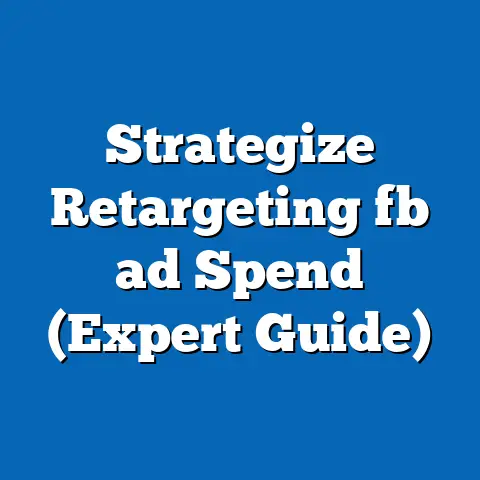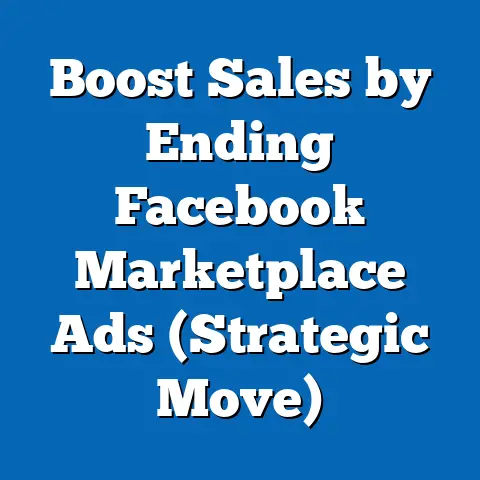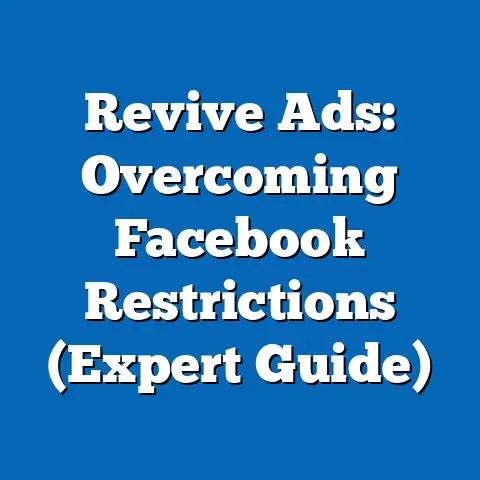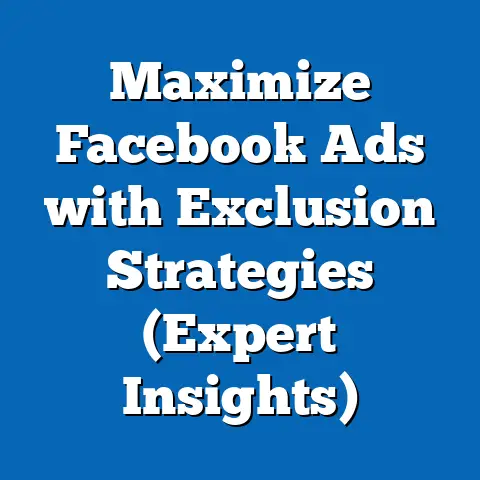Why Is My Facebook Ad Active but Not Running? (Expert Insights)
I remember when I first started running Facebook ads for my online store. I meticulously crafted my ad, targeted my ideal customer, set my budget, and hit “Publish.” I was so excited to see the results. Days turned into a week, and my ad status remained “active,” but it wasn’t running. No impressions, no clicks, no sales. I felt like I was throwing money into a black hole! I was frustrated, confused, and definitely not seeing the ROI I had hoped for. If you’ve ever experienced this, you’re not alone. It’s a common issue that many advertisers face.
In this article, I’m going to break down the common reasons why your Facebook ad might be active but not running and provide expert insights on how to troubleshoot and resolve these issues.
Understanding Facebook Ad Status Terminology
Before diving into the potential problems, it’s crucial to understand what Facebook means by different ad statuses. This clarity is the first step in diagnosing the issue.
-
Active: This status indicates that your ad has been approved by Facebook and is eligible to run. However, it doesn’t guarantee that your ad is actively being shown to your target audience. It simply means that Facebook’s systems haven’t found any immediate issues preventing it from running.
-
In Review: This status means that Facebook is currently reviewing your ad to ensure it complies with its advertising policies. This process can take anywhere from a few minutes to 24 hours, or even longer in some cases. Until the review is complete, your ad will not run.
-
Delivered: This is the status you want to see! It means that your ad is actively being shown to your target audience and is generating impressions.
-
Completed: This status indicates that your ad set or campaign has reached its scheduled end date or lifetime budget.
-
Scheduled: This status means that your ad is scheduled to run in the future.
-
Draft: This status indicates that your ad is not yet submitted for review.
Active: This status indicates that your ad has been approved by Facebook and is eligible to run. However, it doesn’t guarantee that your ad is actively being shown to your target audience. It simply means that Facebook’s systems haven’t found any immediate issues preventing it from running.
In Review: This status means that Facebook is currently reviewing your ad to ensure it complies with its advertising policies. This process can take anywhere from a few minutes to 24 hours, or even longer in some cases. Until the review is complete, your ad will not run.
Delivered: This is the status you want to see! It means that your ad is actively being shown to your target audience and is generating impressions.
Completed: This status indicates that your ad set or campaign has reached its scheduled end date or lifetime budget.
Scheduled: This status means that your ad is scheduled to run in the future.
Draft: This status indicates that your ad is not yet submitted for review.
Takeaway: Understanding these statuses is crucial for monitoring your ad performance and identifying potential issues. If your ad is “active” but not “delivered,” it’s time to investigate further.
Common Reasons for Ads Being Active but Not Running
Let’s explore the most common culprits behind the “active but not running” dilemma.
Ad Review Process
The ad review process is a critical step that every Facebook ad must undergo. Facebook has strict advertising policies in place to ensure a positive user experience and prevent the spread of misleading or harmful content. While seemingly straightforward, the review process can sometimes be the reason behind your ad’s stalled performance.
- Why it matters: Facebook’s review process is designed to ensure that all ads meet their advertising standards. This includes everything from the content of the ad to the targeting options used.
- How it affects delivery: If your ad violates any of Facebook’s policies, it will be disapproved, and you’ll receive a notification explaining the reason for the rejection. Even if your ad seems compliant, it might be flagged for further review, which can delay its delivery.
- Common Reasons for Flagging:
- Misleading Claims: Ads that make unsubstantiated claims or promises can be flagged.
- Prohibited Content: Ads promoting illegal products, services, or activities are strictly prohibited.
- Inappropriate Imagery: Ads containing sexually suggestive, violent, or offensive imagery can be rejected.
- Personal Attributes: Ads that directly address or imply personal attributes such as race, religion, or sexual orientation are not allowed.
- My Experience: I once launched an ad for a weight loss product that was flagged because it contained before-and-after photos. Even though the photos were genuine, Facebook considered them to be making unrealistic claims. I had to revise the ad to focus on the product’s ingredients and benefits without relying on visual comparisons.
- Expert Insight: According to Facebook’s advertising policies, “Ads must not contain content that asserts or implies personal attributes. This is prohibited because such claims can make people feel singled out or targeted.”
- Troubleshooting Tips:
- Review Facebook’s Advertising Policies: Before creating your ad, familiarize yourself with Facebook’s advertising policies to ensure compliance.
- Use Clear and Accurate Language: Avoid making exaggerated claims or using misleading language.
- Choose Appropriate Imagery: Select images that are relevant to your product or service and do not violate any of Facebook’s policies.
- Monitor Your Ads: Regularly check your ad status in Ads Manager to see if any of your ads have been disapproved. If an ad is disapproved, review the reason and make the necessary changes.
- Misleading Claims: Ads that make unsubstantiated claims or promises can be flagged.
- Prohibited Content: Ads promoting illegal products, services, or activities are strictly prohibited.
- Inappropriate Imagery: Ads containing sexually suggestive, violent, or offensive imagery can be rejected.
- Personal Attributes: Ads that directly address or imply personal attributes such as race, religion, or sexual orientation are not allowed.
- Review Facebook’s Advertising Policies: Before creating your ad, familiarize yourself with Facebook’s advertising policies to ensure compliance.
- Use Clear and Accurate Language: Avoid making exaggerated claims or using misleading language.
- Choose Appropriate Imagery: Select images that are relevant to your product or service and do not violate any of Facebook’s policies.
- Monitor Your Ads: Regularly check your ad status in Ads Manager to see if any of your ads have been disapproved. If an ad is disapproved, review the reason and make the necessary changes.
Takeaway: The ad review process is a crucial step that can impact ad delivery. Make sure your ads comply with Facebook’s advertising policies to avoid delays or disapprovals.
Target Audience Restrictions
One of the most powerful aspects of Facebook advertising is its ability to target specific audiences based on a wide range of demographics, interests, and behaviors. However, overly narrow audience targeting can sometimes backfire, resulting in limited reach and preventing your ad from running effectively.
- Why it matters: Your target audience is the group of people you want to reach with your ads. If your audience is too small, Facebook may not be able to find enough people who match your criteria, which can limit your ad’s delivery.
- How it affects delivery: Facebook needs a sufficient pool of potential customers to effectively deliver your ads. If your audience is too niche, you might be missing out on valuable opportunities to reach a broader audience.
- Statistics: According to Facebook, a target audience should ideally consist of at least 1,000 people for optimal ad delivery.
- Checking Your Audience Size:
- Facebook Ads Manager: When creating your ad, Facebook Ads Manager will provide an estimated audience size based on your targeting criteria.
- Audience Definition: Pay attention to the audience definition meter, which indicates whether your audience is too broad, balanced, or too specific.
- My Experience: I once created an ad campaign for a local bakery targeting only people who lived within a 1-mile radius of the store and who were interested in gluten-free products. While the targeting was highly specific, the audience size was too small, and the ad barely ran. I had to expand the radius and broaden the interest targeting to increase the audience size and improve ad delivery.
- Expert Insight: According to Neil Patel, “Don’t be afraid to test broader audiences. Sometimes, you’ll be surprised at who converts.”
- Troubleshooting Tips:
- Expand Your Targeting Criteria: If your audience is too small, consider broadening your targeting criteria by adding more interests, demographics, or behaviors.
- Use Lookalike Audiences: Create lookalike audiences based on your existing customer data to reach new people who are similar to your best customers.
- Layer Your Targeting Carefully: Avoid layering too many targeting options on top of each other, as this can significantly narrow your audience.
- Test Different Audience Sizes: Experiment with different audience sizes to see what works best for your ad campaign.
- Facebook Ads Manager: When creating your ad, Facebook Ads Manager will provide an estimated audience size based on your targeting criteria.
- Audience Definition: Pay attention to the audience definition meter, which indicates whether your audience is too broad, balanced, or too specific.
- Expand Your Targeting Criteria: If your audience is too small, consider broadening your targeting criteria by adding more interests, demographics, or behaviors.
- Use Lookalike Audiences: Create lookalike audiences based on your existing customer data to reach new people who are similar to your best customers.
- Layer Your Targeting Carefully: Avoid layering too many targeting options on top of each other, as this can significantly narrow your audience.
- Test Different Audience Sizes: Experiment with different audience sizes to see what works best for your ad campaign.
Takeaway: Overly narrow audience targeting can limit ad delivery. Broaden your targeting criteria or use lookalike audiences to increase your reach and improve ad performance.
Budget and Bidding Issues
Your budget and bidding strategy play a crucial role in determining how your ads are delivered on Facebook. Incorrect budget settings or ineffective bidding strategies can prevent your ads from running effectively.
- Why it matters: Your budget is the amount of money you’re willing to spend on your ad campaign, while your bidding strategy determines how Facebook allocates your budget to reach your target audience.
- How it affects delivery: If your budget is too low or your bidding strategy is not optimized, your ads may not be shown to enough people, resulting in limited delivery.
- Budget Settings (Daily vs. Lifetime):
- Daily Budget: A daily budget sets a fixed amount that you’re willing to spend on your ad each day.
- Lifetime Budget: A lifetime budget sets a total amount that you’re willing to spend on your ad campaign over its entire duration.
- Bidding Strategies:
- Lowest Cost: Facebook automatically bids to get you the most results for your budget.
- Target Cost: Facebook aims to get you the most results at or below your target cost per result.
- Manual Bidding: You set the maximum amount you’re willing to pay for each result.
- My Experience: I once ran an ad campaign with a daily budget of just $5 and a lowest cost bidding strategy. While the ad was active, it barely generated any impressions or clicks. I realized that my budget was too low to compete with other advertisers targeting the same audience. I increased my daily budget to $20, and the ad started running much more effectively.
- Expert Insight: According to HubSpot, “Your Facebook ad budget should be based on your business goals and the value of each conversion.”
- Troubleshooting Tips:
- Increase Your Budget: If your budget is too low, consider increasing it to improve ad delivery.
- Optimize Your Bidding Strategy: Experiment with different bidding strategies to see what works best for your ad campaign.
- Monitor Your Ad Spend: Regularly check your ad spend in Ads Manager to ensure that you’re not overspending or underspending.
- Adjust Your Budget Over Time: As your ad campaign progresses, you may need to adjust your budget based on its performance.
- Daily Budget: A daily budget sets a fixed amount that you’re willing to spend on your ad each day.
- Lifetime Budget: A lifetime budget sets a total amount that you’re willing to spend on your ad campaign over its entire duration.
- Lowest Cost: Facebook automatically bids to get you the most results for your budget.
- Target Cost: Facebook aims to get you the most results at or below your target cost per result.
- Manual Bidding: You set the maximum amount you’re willing to pay for each result.
- Increase Your Budget: If your budget is too low, consider increasing it to improve ad delivery.
- Optimize Your Bidding Strategy: Experiment with different bidding strategies to see what works best for your ad campaign.
- Monitor Your Ad Spend: Regularly check your ad spend in Ads Manager to ensure that you’re not overspending or underspending.
- Adjust Your Budget Over Time: As your ad campaign progresses, you may need to adjust your budget based on its performance.
Takeaway: Your budget and bidding strategy are critical factors that influence ad delivery. Optimize your budget and bidding strategy to ensure that your ads are reaching your target audience effectively.
Ad Scheduling Concerns
Ad scheduling allows you to specify the days and times when you want your ads to run. While this feature can be useful for targeting specific time periods, incorrect ad scheduling can prevent your ads from running as intended.
- Why it matters: Ad scheduling allows you to target your audience when they are most likely to be active on Facebook. However, incorrect settings can lead to missed opportunities and prevent your ads from running.
- How it affects delivery: If your ad is scheduled to run only during specific hours or days, it will not be shown outside of those times, even if your budget and targeting are optimal.
- Start and End Dates:
- Setting Specific Dates: Make sure that your ad’s start and end dates are correctly set. If the start date is in the future, your ad will not run until that date arrives.
- Avoiding Premature End Dates: Ensure that your ad’s end date is far enough in the future to allow it to run for the desired duration.
- Time Zone Settings:
- Account Time Zone: Your Facebook ad account has a default time zone setting.
- Scheduling Conflicts: Be aware of the time zone settings when scheduling your ads. If your ad is scheduled to run during specific hours in one time zone, it may not run at the intended times in other time zones.
- My Experience: I once launched an ad campaign for a restaurant targeting lunch and dinner hours. However, I forgot to adjust the time zone settings, and the ad was running during the middle of the night instead. I had to correct the time zone settings to ensure that the ad was running during the restaurant’s business hours.
- Expert Insight: According to Social Media Examiner, “Test different ad schedules to see when your target audience is most active on Facebook.”
- Troubleshooting Tips:
- Verify Start and End Dates: Double-check your ad’s start and end dates to ensure they are correctly set.
- Adjust Time Zone Settings: Be mindful of the time zone settings when scheduling your ads.
- Monitor Your Ad Delivery: Regularly check your ad’s delivery in Ads Manager to see if it’s running as intended.
- Experiment with Different Schedules: Test different ad schedules to see what works best for your target audience.
- Setting Specific Dates: Make sure that your ad’s start and end dates are correctly set. If the start date is in the future, your ad will not run until that date arrives.
- Avoiding Premature End Dates: Ensure that your ad’s end date is far enough in the future to allow it to run for the desired duration.
- Account Time Zone: Your Facebook ad account has a default time zone setting.
- Scheduling Conflicts: Be aware of the time zone settings when scheduling your ads. If your ad is scheduled to run during specific hours in one time zone, it may not run at the intended times in other time zones.
- Verify Start and End Dates: Double-check your ad’s start and end dates to ensure they are correctly set.
- Adjust Time Zone Settings: Be mindful of the time zone settings when scheduling your ads.
- Monitor Your Ad Delivery: Regularly check your ad’s delivery in Ads Manager to see if it’s running as intended.
- Experiment with Different Schedules: Test different ad schedules to see what works best for your target audience.
Takeaway: Incorrect ad scheduling can prevent your ads from running effectively. Verify your start and end dates, adjust time zone settings, and monitor your ad delivery to ensure that your ads are running as intended.
Impact of Ad Quality and Relevance
The quality and relevance of your ad play a significant role in determining its performance on Facebook. Facebook prioritizes ads that are engaging, informative, and relevant to its users.
Ad Quality Score
Facebook uses an ad quality score to assess the overall quality and relevance of your ad. This score is based on several factors, including:
- Relevance: How well your ad matches the interests and preferences of your target audience.
- Engagement: The level of interaction your ad receives, such as likes, comments, and shares.
- Landing Page Experience: The quality and relevance of the landing page that your ad directs users to.
- Feedback: Negative feedback from users, such as hiding the ad or reporting it as spam.
Engagement Metrics
Engagement metrics provide valuable insights into how users are interacting with your ad. Low engagement rates can lead to reduced delivery, as Facebook may perceive your ad as being less relevant or interesting to its users.
-
Key Engagement Metrics:
- Click-Through Rate (CTR): The percentage of people who see your ad and click on it.
- Conversion Rate: The percentage of people who click on your ad and complete a desired action, such as making a purchase or filling out a form.
- Cost Per Result: The average cost you pay for each result, such as a click, conversion, or lead.
-
Impact of Low Engagement:
- Reduced Delivery: Facebook may reduce the delivery of ads with low engagement rates.
- Increased Costs: You may pay more for each result if your ad has low engagement.
- Lower ROI: Low engagement can lead to a lower return on investment for your ad campaign.
-
My Experience: I once ran an ad campaign with a poorly designed ad creative and generic ad copy. The ad had a very low click-through rate and a high cost per result. I realized that the ad was not engaging or relevant to my target audience. I redesigned the ad creative, rewrote the ad copy, and saw a significant improvement in engagement rates and ad performance.
-
Expert Insight: According to WordStream, “A high-quality ad is more likely to be shown to a wider audience at a lower cost.”
-
Troubleshooting Tips:
- Improve Your Ad Creative: Use high-quality images or videos that are visually appealing and relevant to your target audience.
- Write Compelling Ad Copy: Craft ad copy that is clear, concise, and persuasive.
- Target the Right Audience: Ensure that you are targeting the right audience with your ads.
- Optimize Your Landing Page: Make sure that your landing page is relevant to your ad and provides a seamless user experience.
- Monitor Your Engagement Metrics: Regularly check your engagement metrics in Ads Manager to see how your ads are performing.
- A/B Test Your Ads: Experiment with different ad creatives, ad copy, and targeting options to see what works best.
Key Engagement Metrics:
- Click-Through Rate (CTR): The percentage of people who see your ad and click on it.
- Conversion Rate: The percentage of people who click on your ad and complete a desired action, such as making a purchase or filling out a form.
- Cost Per Result: The average cost you pay for each result, such as a click, conversion, or lead.
Impact of Low Engagement:
- Reduced Delivery: Facebook may reduce the delivery of ads with low engagement rates.
- Increased Costs: You may pay more for each result if your ad has low engagement.
- Lower ROI: Low engagement can lead to a lower return on investment for your ad campaign.
My Experience: I once ran an ad campaign with a poorly designed ad creative and generic ad copy. The ad had a very low click-through rate and a high cost per result. I realized that the ad was not engaging or relevant to my target audience. I redesigned the ad creative, rewrote the ad copy, and saw a significant improvement in engagement rates and ad performance.
Expert Insight: According to WordStream, “A high-quality ad is more likely to be shown to a wider audience at a lower cost.”
Troubleshooting Tips:
- Improve Your Ad Creative: Use high-quality images or videos that are visually appealing and relevant to your target audience.
- Write Compelling Ad Copy: Craft ad copy that is clear, concise, and persuasive.
- Target the Right Audience: Ensure that you are targeting the right audience with your ads.
- Optimize Your Landing Page: Make sure that your landing page is relevant to your ad and provides a seamless user experience.
- Monitor Your Engagement Metrics: Regularly check your engagement metrics in Ads Manager to see how your ads are performing.
- A/B Test Your Ads: Experiment with different ad creatives, ad copy, and targeting options to see what works best.
Takeaway: Ad quality and relevance are crucial factors that influence ad delivery. Improve your ad creative, write compelling ad copy, target the right audience, and optimize your landing page to increase engagement rates and improve ad performance.
Technical Issues and Glitches
Sometimes, the reason your ad is active but not running may be due to technical issues or glitches within the Facebook Ads platform.
Platform Bugs
Like any complex software system, Facebook’s ad platform is not immune to bugs and glitches. These technical issues can sometimes cause discrepancies in ad delivery and prevent ads from running as intended.
- Why it matters: Platform bugs can affect ad delivery and performance, even if your ad is compliant with Facebook’s policies and your settings are correctly configured.
- Troubleshooting Steps:
- Check for System Alerts: Regularly check Facebook’s system status page or Ads Manager for any reported issues or outages.
- Clear Your Browser Cache: Clearing your browser cache and cookies can sometimes resolve minor technical glitches.
- Try a Different Browser: If you’re experiencing issues with one browser, try using a different browser to see if the problem persists.
- Contact Facebook Support: If you suspect a platform bug is affecting your ad delivery, contact Facebook Support for assistance.
- Check for System Alerts: Regularly check Facebook’s system status page or Ads Manager for any reported issues or outages.
- Clear Your Browser Cache: Clearing your browser cache and cookies can sometimes resolve minor technical glitches.
- Try a Different Browser: If you’re experiencing issues with one browser, try using a different browser to see if the problem persists.
- Contact Facebook Support: If you suspect a platform bug is affecting your ad delivery, contact Facebook Support for assistance.
Account Health
Your account health and previous ad performance can also affect the delivery of your current campaigns.
- Why it matters: Facebook wants to ensure that advertisers are following its policies and providing a positive user experience. If your account has a history of policy violations or poor ad performance, it can impact the delivery of your future campaigns.
- Troubleshooting Steps:
- Review Your Account History: Check your account history for any policy violations or disapprovals.
- Improve Your Ad Quality: Focus on creating high-quality, engaging ads that comply with Facebook’s policies.
- Contact Facebook Support: If you believe your account health is affecting your ad delivery, contact Facebook Support for assistance.
- Review Your Account History: Check your account history for any policy violations or disapprovals.
- Improve Your Ad Quality: Focus on creating high-quality, engaging ads that comply with Facebook’s policies.
- Contact Facebook Support: If you believe your account health is affecting your ad delivery, contact Facebook Support for assistance.
Real-World Case Studies
To further illustrate these points, let’s look at a couple of real-world examples:
Case Study 2: The Software Company: A software company launched a Facebook ad campaign promoting a new product. The ad was active but not running. After checking their account health, they discovered that they had a previous policy violation. They addressed the violation, improved their ad quality, and saw a positive impact on ad delivery.
Case Study 2: The Software Company: A software company launched a Facebook ad campaign promoting a new product. The ad was active but not running. After checking their account health, they discovered that they had a previous policy violation. They addressed the violation, improved their ad quality, and saw a positive impact on ad delivery.
Summarizing Key Insights
As you can see, there are many reasons why your Facebook ad might be active but not running. By understanding the common causes and troubleshooting steps, you can identify and resolve these issues and get your ads running effectively.
- Ad Review Process: Ensure your ads comply with Facebook’s advertising policies.
- Target Audience Restrictions: Broaden your targeting criteria or use lookalike audiences.
- Budget and Bidding Issues: Optimize your budget and bidding strategy.
- Ad Scheduling Concerns: Verify your start and end dates and adjust time zone settings.
- Ad Quality and Relevance: Improve your ad creative, write compelling ad copy, and target the right audience.
- Technical Issues and Glitches: Check for system alerts, clear your browser cache, and contact Facebook Support.
- Account Health: Review your account history and improve your ad quality.
Facebook advertising can be complex, but by taking a proactive approach and staying informed about best practices, you can overcome these challenges and achieve your advertising goals. Don’t give up! With a little troubleshooting and optimization, you can get your ads running and start seeing the results you deserve.





